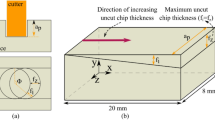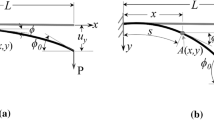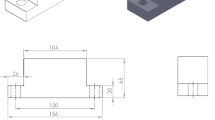Abstract
Tool deflection of end mills caused by cutting forces has a great effect on the machining quality and efficiency. Cylindrical cantilever beam model with 80 % of tool radius is generally used to predict the tool deflection roughly. But that ignored the complex geometrical structure of end mills, which is manufactured with a set of grinding operations. In this study, the geometrical model of end mill is developed based on the CAD/CAM integration via modeling its grinding processes. Using the developed CAD model, the cutting coefficients and distributed cutting forces along the tool axis are obtained via finite element analysis of cutting simulation. Besides, the moment of inertia along the tool axis is also precisely measured based on the CAD model. Finally, with the measured inertia and distributed cutting forces, the tool defection can be predicted accurately with the unit loading algorithm for the cantilever beam. This study provides an accurate approach to predicting tool deflection of end mills based on the CAD/CAM/CAE integration.
Similar content being viewed by others
References
Kline WA, DeVor RE, Shareef IA (1982) The prediction of surface accuracy in end milling. ASME J Eng Ind 104(3):272–278
Altintas Y (2000) Manufacturing automation: metal cutting mechanics, machine tool vibrations, and CNC design. Cambridge University Press, New York
Shaw MC (2005) Metal cutting principles. Oxford University Press, New York
Boothroyd G, Knight WA (2006) Fundamentals of machining and machine tools. Taylor and Francis, Boca Raton
Cheng K (2009) Machining dynamics: fundamentals, applications and practice. Springer, London
Jiang F, Li JF, Yan L et al (2010) Optimizing end-milling parameters for surface roughness under different cooling/lubrication conditions. Int J Adv Manuf Technol 51:841–851
Salgado MA, Lacalle LNL, Lamikiz A, Munoa J, Sanchez JA (2005) Evaluation of the stiffness chain on the deflection of end-mills under cutting forces. Int J Mach Tools Manuf 45(6):727–739
Ratchev S, Liu S, Huang W, Becker AA (2007) Machining simulation and system integration combining FE analysis and cutting mechanics modelling. Int J Adv Manuf Technol 35(1–2):55–65
Kops L, Vo DT (1990) Determination of the equivalent diameter of an end mill based on its compliance. CIRP Ann Manuf Technol 39:93–96
Xu AP, Qu YX, Zhang DW, Huang T (2003) Simulation and experimental investigation of the end milling process considering the cutter flexibility. Int J Mach Tools Manuf 43:283–292
Lapez DL, Lamikiz A, SAnchez JA, Salgado MA (2004) Effects of tool deflection in the high-speed milling of inclined surfaces. Int J Adv Manuf Technol 24:621–631
Larue A, Anselmetti B (2004) A prediction of the machining defects in flank milling. Int J Adv Manuf Technol 24:102–111
Kim SJ (2007) Short and safe tool setting by safe space in NC machining. Int J Adv Manuf Technol 33:1017–1023
Kivanc EB, Budak E (2004) Structural modeling of end mills for form error and stability analysis. Int J Mach Tools Manuf 44:1151–1161
Chen J, Lee BY, Chen CH (2008) Planning and analysis of grinding processes for end mills of cemented tungsten carbide. J Mater Process Technol 201:618–622
Kaldor S, Rafael AM, Messinger D (1988) On the CAD of profiles for cutters and helical flutes—geometrical aspects. CIRP Ann Manuf Technol 37:53–56
Kim Y, Ko S (2002) Development of design and manufacturing technology for end mills in machining hardened steel. J Mater Process Technol 130:653–661
Rababah, MM, Chen, ZC, Wang, LM (2012) A new approach to five-axis CNC flute grinding of solid end-mills. ICHSM2012: 421–432
Kim JH, Park JW, Ko TJ (2008) End mill design and machining via cutting simulation. CAD 40:324–333
Author information
Authors and Affiliations
Corresponding author
Rights and permissions
About this article
Cite this article
Wang, L., Chen, Z.C. A new CAD/CAM/CAE integration approach to predicting tool deflection of end mills. Int J Adv Manuf Technol 72, 1677–1686 (2014). https://doi.org/10.1007/s00170-014-5760-4
Received:
Accepted:
Published:
Issue Date:
DOI: https://doi.org/10.1007/s00170-014-5760-4




